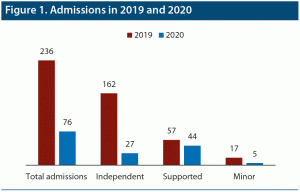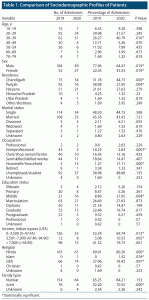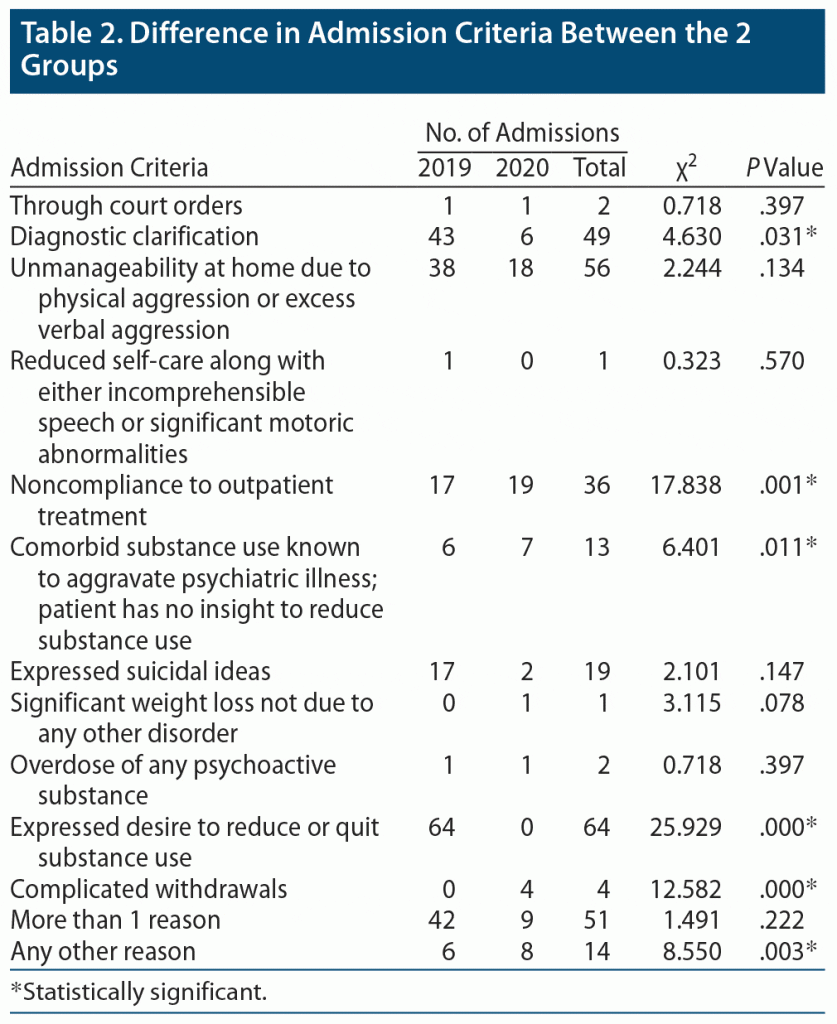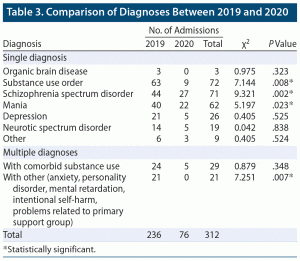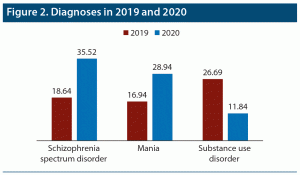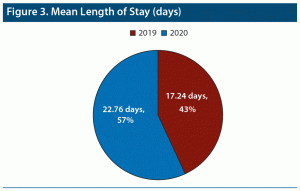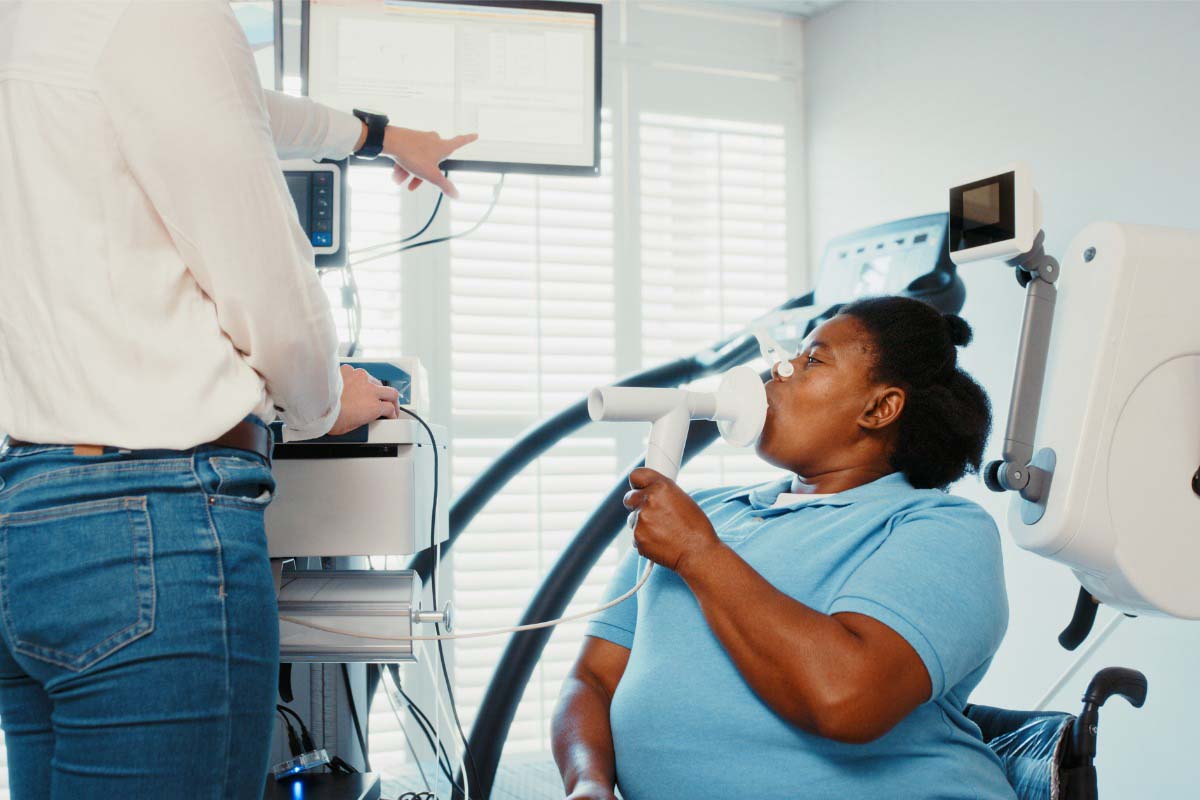ABSTRACT
Objective: To study the pattern of admissions in a psychiatry ward during the coronavirus disease 2019 (COVID-19) pandemic and compare the sociodemographic and clinical profiles of patients admitted in 2020 with admissions in 2019.
Methods: The case record files of an inpatient psychiatric unit from March 23 to September 22, 2019, and March 23 to September 22, 2020 were retrieved. Sociodemographic data, admission criteria of the patients, clinical diagnosis (as per ICD-10 criteria), duration of stay in the ward, and details of capacity assessment were assessed. The data collected were tabulated as per coding system and analyzed and compared using statistical analysis system software.
Results: Of a total of 312 admissions, 236 were in 2019 and 76 were in 2020 (P < .05), which was a significant (P < .05) decrease. More patients admitted in 2020 were in the age group of 30–39 years (P < .05), were residents of Chandigarh (P < .05), were housewives by occupation (P < .05), had incomes < 3,500 Indian rupees (US$ 48.01) per month (P < .01), were Hindu, and belonged to extended families (P < .05). The predominant reasons for admission in 2020 were complicated withdrawals, noncompliance to treatment (P < .05), and aggravation of psychiatric illness due to comorbid substance use. The ICD diagnoses schizophrenia, schizotypal and delusional disorder (F20–29) and mood disorders, predominantly mania (F30–31) were significantly higher and mental and behavioral disorder due to psychoactive substance use (F10-19) was lower among patients admitted in 2020.
Conclusions: The results show that the numbers of admissions to the psychiatry ward in 2020 were significantly lower than pre-COVID 2019, and the predominant reasons for admission were complicated withdrawals due to psychoactive substance abuse and noncompliance to treatment. Also, the mean duration of stay was longer in 2020 compared to the previous year.
Prim Care Companion CNS Disord 2021;23(3):21m02936
To cite: Sidana A, Goel V, Kaur S. Impact of the COVID-19 pandemic on psychiatric hospitalization in a tertiary care hospital of Northern India. Prim Care Companion CNS Disord. 2021;23(3):21m02936.
To share: https://doi.org/10.4088/PCC.21m02936
© Copyright 2021 Physicians Postgraduate Press, Inc.
aDepartment of Psychiatry, Government Medical College and Hospital, Chandigarh, India
*Corresponding author: Ajeet Sidana, MD, Department of Psychiatry, Government Medical College and Hospital, Sector-32, Chandigarh (UT), India 160030 ([email protected]).
The coronavirus disease 2019 (COVID-19) pandemic has had a tremendous impact worldwide. The first case of COVID-19 infection was reported in Wuhan City, China in December 2019. India diagnosed its first case on January 30, 2020 in a 20-year-old woman who had returned to Kerala from Wuhan City, China. The transmission rate of the novel coronavirus has been expeditious. Since then, India has seen a substantial rise in COVID-19 cases. Given the rapid transmission of the virus, the World Health Organization first announced a public health emergency of international concern and subsequently on March 11, 2020 declared COVID-19 a global pandemic. To contain the spread of infection, India was locked down for a period of 3 weeks starting March 25, 2020. Due to the growing number of cases, the lockdown was further extended to May 3, 2020. As of January 1, 2021, a total of 81,947,503 people have been infected with COVID-19, and 1,808,041 have died.1
The nationwide lockdown has dramatically affected every aspect of people’s lives. The psychological aftermath associated with COVID-19 infection, fear of the virus, and quarantine is immense. The COVID-19 pandemic has had a significant negative effect on the mental health of individuals.2 There has been aggravation of existing or new onset of psychiatric disorders secondary to social distancing, quarantine, and the lockdowns.3,4 An increase has been seen in the number of individuals presenting with depression, stress, irritability, anger, insomnia, substance use, and domestic violence.5 Numerous studies4,6,7 have been carried out in various states of India to determine the effect of COVID-19 on the mental health of previously healthy functioning individuals. One study8 reported a moderate level of stress in approximately three-fourths of the participants and anxiety in the remaining one-third. Studies9–11 also revealed that the quarantine had a huge impact on those already experiencing mental illness. Although the reported symptoms were almost similar, there was an increase in severity of symptoms. Patients reported a high degree of concern about their general health, and an increase was seen in anger, impulsivity, and suicidal ideation.12
There have been extensive studies13,14 reporting the impact of lockdown on the mental health of individuals and the challenges faced by treatment teams in the management of psychiatrically ill patients. Another study15 focused on the containment of infection if there is an outbreak within a psychiatric intensive care unit. However, to date, we found only 2 significant studies reporting the variation in demographics of inpatient psychiatric hospitalizations during the COVID-19 pandemic. A study16 conducted in the Lombard region of Italy compared the rates of pre-COVID and COVID admissions in 2019 and 2020, respectively. The results showed a marked reduction in the rate of total psychiatric admissions. Independent admissions decreased; however, the rates of supported admissions were found to be similar.16 A study17 from Melbourne, Australia concluded that individuals with a diagnosis of substance use disorder (SUD) were more likely to receive inpatient services compared to individuals with severe mental illness. Also, individuals with a separated relationship status sought inpatient treatment more often than others.17
The current scenario of lockdown and restrictions secondary to COVID-19 has many implications for treatment seekers. A complete understanding of sociodemographic data, admission criteria of the patient, clinical diagnosis, and duration of stay is currently unavailable. We believe that detailed evaluation of the profiles of patients needing inpatient care will guide us further and help to formulate plans and policies for better understanding and management of these patients. Hence, the objective of this study was to investigate the pattern of admissions in a psychiatry ward during the COVID-19 pandemic and compare the sociodemographic and clinical profiles of patients admitted in 2020 with those in 2019.
METHODS
The study was conducted at the Department of Psychiatry of Government Medical College and Hospital (GMCH), Chandigarh, India. The GMCH is a well-known tertiary care teaching hospital and caters to patients across India, predominately from the states of Punjab, Haryana, Himachal, and Chandigarh. The study design was retrospective, case control, and comparative in nature. The case record files of inpatients admitted to the psychiatric unit from March 23 to September 22, 2019, and March 23 to September 22, 2020 were retrieved. A total of 312 files were screened. The information extracted included sociodemographic data such as age, sex, residence, education status, occupation, marital status, income per month, and locality. Furthermore, admission criteria of the patient, clinical diagnosis (as per ICD-10 criteria),18 duration of stay, and details of capacity assessment for the type of admission were assessed. The admissions were of 2 types: (1) independent admission refers to a patient having the mental capacity to make decisions regarding treatment or admission and (2) supported admission refers to a patient who lacks the mental capacity required to make decisions about treatment or admission and further requires the support from relatives as per India’s Mental Health Care Act, 2017.19 Information regarding noncompliance was elicited by interviewing the caregivers and the patient. The data collected were tabulated and analyzed as per coding system. The enumerated data of the 2019 patients (controls) were compared with that of the 2020 patients (cases) using statistical analysis system software.
Statistical Analysis
SPSS Statistics software was used for the statistical analysis. Descriptive statistics were calculated. All of the responses were compared using t test and χ2 test, and a P value ≤ .05 was considered statistically significant. The study was approved by the institutional ethics committee.
RESULTS
Of a total of 312 admissions, 236 patients were admitted during the 6-month period in 2019 compared to only 76 patients during the 6-month period in 2020, indicating a decrease of 67.7% (P < .05) (Figure 1). In 2020, independent admissions decreased 33.12% (P < .05); however, supported admissions increased by 33.74% (P < .05).
Sociodemographic Profiles of the Patients
Most patients seeking treatment in 2019 were in the age group 20–29 years. However, in 2020, more patients were from the age group 30–39 years, which was a significant increase of 14.52% (P = .16) from 2019 in this age range. Men outnumbered women in both years. An increase of 4.4% was seen in divorced individuals seeking treatment in 2020 (P = .055, not significant).
In 2019, most patients were from the nearby state of Punjab (38.98%), Chandigarh (site of study, 31.78%), and Haryana (21.61%). In 2020, following the imposition of lockdown, the predominant admissions were from Chandigarh (44.73%) followed by Haryana (27.63%) and Punjab (21.05%). In 2020, there was an increase of 12.98% (P < .05) in patients from Chandigarh and a decrease of 17.93% (P = .004) in patients rom Punjab compared to 2019.
A significant increase of 12.16% (P = .004) was seen in patients admitted during 2020 who had at least a middle school education, with no significant change in other educational categories. With regard to occupation, during 2020 a decline of 15.59% (P < .05) was seen in semiprofessionals; however, an increase of 15.84% (P < .05) and 9.7% (P = .135) was seen in housewives and unemployed patients, respectively. During the pandemic, a shift in income subgroups was noticed, as there was an increase of 16.35% (P = .01) in patients earning < 3,500 Indian rupees (US$ 48.01) per month and a decrease of 21.79% (P = .001) in patients earning > 7,000 Indian rupees (US$ 96.01) per month (Table 1).
Patients seeking inpatient treatment who belonged to the Hindu religion increased significantly by 10.35% (P < .05) in 2020, whereas change in patients with other religious affiliations was not significant. With regard to family structure, patients from nuclear families increased by 18.96% during the 6-month period in 2020, while those from joint families decreased by 21.68% (P < .05) during the same period.
Admission Criteria
Analysis of the admission criteria is shown in Table 2. In 2020, there was an increase of 6.67% (P = .011) in admissions due to aggravation of psychiatric illness with comorbid substance use. An increase of 5.26% (P < .05) was seen in admissions due to complicated withdrawals, and admissions due to noncompliance to treatment increased by 17.8% (P < .05). An increase of 7.58% occurred in admissions in 2020 due to unmanageability at home; however, it was not significant (P = .134). In 2020, a decrease of 10.33% (P = .031) occurred in admissions for diagnostic clarification. Admissions of individuals expressing desire to quit psychoactive substance decreased by 27.11% (P < .05).
Diagnostic Breakdown
Diagnostic breakdowns of patients in 2019 and 2020 are provided in Table 3 and Figure 2. Inpatients with an ICD-10 diagnosis of schizophrenia, schizotypal and delusional disorder (F20-29) increased by 16.88% (P = .002) in 2020; similarly, an increase of 12% (P = .023) was seen in patients with a diagnosis of mood disorders, predominantly mania (F30-31). In 2020, a decline of 14.85% (P = .008) occurred in patients with the diagnosis of mental and behavioral disorder due to psychoactive substance use (F10-19).
Length of Stay
The mean length of stay during the control period in 2019 was 17.24 days (SD = 13.39) and during the study period in 2020 was 22.76 days (SD = 15.324), which was a statistically significant increase (P = .003) (Figure 3).
DISCUSSION
The COVID-19 pandemic posed unique challenges for psychiatric inpatient care. To maintain services during this time, various steps were taken as a part of a contingency plan. Precautions included screening patients prior to admission, use of personal protective equipment, repeated cleaning and disinfection of surfaces, restriction of visitors, minimization of nonessential contact, creation of backup workforce pools, use of isolation rooms, use of stricter admission criteria, and discontinuation of group therapies.13
The pandemic, subsequent lockdowns and restricted movement, quarantine, and alterations in the admission process changed the various facets of inpatient psychiatric care. Our results showed a decline of 67.7% in the total number of inpatient admissions during the 2020 study period compared to that of 2019, which is in line with findings of studies conducted in Italy16 and Germany.20 This finding is contrary to the increase in number of mental health issues during the lockdown. The decrease in number of psychiatric admissions could be due to various factors. First, there might be undue fear in the minds of patients and their family members with regard to contracting COVID-19 in the hospital setting. Second, there may have been better symptom management by family members, as everyone was at home to address the patient’s needs. Third, it might have been difficult to be admitted to the psychiatry ward due to the requirement of a negative COVID-19 test before admission. Fourth, they might have sought treatment from telemedicine services for control of symptoms. Fifth, fewer numbers of patients may have presented to the hospital due to imposition of strict border policies by state governments or a combination of many factors. After India was put under lockdown, the majority of admitted patients were from the nearby area of Chandigarh rather than from the farther catchment areas of our tertiary care hospital. This finding is attributable to the lack of transport services and also the need for passes issued by the government to move between states. This study highlights an increase in patients belonging to nuclear families and from lower economic strata and unemployed and housewive/household groups as well as a simultaneous decline in patients belonging to joint families and from higher economic and occupational backgrounds. Financial constraints, lack of social support, and inadequate information act as stressors, further affecting the mental health of individuals during tough times.21
Another major finding of our study suggests a decline in independent admissions as per the Mental Health Care Act, 2017.19 This decline is reflected by smaller proportions of patients admitted in the year 2020 with diagnoses of SUDs, depression, or neurotic spectrum disorders. It could also be possible that these disorders might be less severe and hence managed through e-mental health services. The mean length of stay increased during lockdown to 22.7 days from 17.15 days in 2019. This increase could be due to more psychopathology at presentation as more admissions were under the supported category or to delay in initiation of detailed workup of cases and discussion with the consultant in view of a pending COVID-19 report or both. The treatment team was met with the challenge of disposition planning, especially for patients having issues with housing instability. Adding to the burden, halfway homes and day care hospitals were also not functional.
Noncompliance increased after the imposition of lockdown due to restriction in movement and difficulty in procuring psychiatric medication without prescription.10 Telemedicine, although initiated but being a relatively new concept in India, had its own challenges in the outreach to peripheral areas.
One of the key findings suggests an increase in admissions with a diagnosis of schizophrenia, schizotypal and delusional disorder (F20-29) and mood disorders, predominantly mania (F30-31), mostly exacerbating after noncompliance to treatment. Case reports and observational studies22,23 support the previously mentioned findings. A probable correlation exists between stress, anxiety, and fear associated with the COVID-19 virus and the onset of psychosis. A study22 from China reported a 25% increase in the incidence of schizophrenia in previously healthy individuals during the COVID-19 pandemic. In people infected with COVID-19, there has been increased reporting of psychotic symptoms. Also, there is a single case report24 on the onset of mania-like symptoms in a COVID-19–positive individual. However, a causal relationship cannot be inferred because of the numerous factors leading to the precipitation of an illness. Independent admissions to quit substances of abuse decreased. Tighter admission criteria also played a part in decreased independent admissions, as leave parole was not allowed during the study period. However, the number of patients presenting with complicated withdrawals increased due to forced attempts of abstinence primarily due to nonavailability of substances during lockdown and inability to procure medication without renewal of prescription.25
Studies conducted in Italy16 and Australia17 have also compared the rate of admissions between pre-COVID and COVID times in 2019 and 2020. The Italian study16 indicated a decline in the rate of total psychiatric admissions as well as a reduction in independent admissions. The Australian study17 showed that during the initial phase, independent admissions were higher, but in the later phase compulsory admissions increased. The Australian study17 mentions that individuals with a diagnosis of SUD were more likely to receive inpatient services compared to individuals with severe mental illness. This finding is in contrast to those of our study but could be because patients with severe mental illness had access to the Mental Health Institute in Chandigarh and telemedicine services were available for patients with mental health issues and SUDs.
The studies from Australia17 and Italy16 reported a reduction in independent admissions; this finding is in line with those of our study. Additionally, an increase in the number of supported admissions was found in our study. The detailed evaluation of the sociodemographic profiles of patients revealed an increase in the number of patients in the age group 30–39 years. Housewives sought treatment more often than individuals of other occupations, and an increase was seen in the number of individuals earning < 3,500 Indian rupees (US$ 48.01) per month. People seeking treatment were mostly from nearby cities, were Hindu, and belonged to nuclear families. Admissions occurring due to noncompliance and complicated withdrawals increased. These findings are unique to this study and have not been researched to date. Another important finding was the increase in the number of psychotic and manic patients. This finding can be corroborated with that of studies conducted in China and Malaysia.26
There are a few limitations to our study. First, a comparison could also be drawn for admissions under the independent and supported categories in relation to diagnosis and length of stay. Second, admissions to other departments of the hospital would have further widened the scope of the study. Nevertheless, this study is a unique effort to understand the change in the dynamics of inpatient utilization of mental health care facilities during the peak of the COVID-19 pandemic.
CONCLUSION
The results of our study show a reduction in the total number of admissions and independent admissions in 2020; however, the proportion of patients in the supported admissions category increased during the COVID-19 pandemic. Inpatient mental health services were mostly utilized by patients from Chandigarh. Noncompliance to treatment leading to hospitalization and complicated withdrawals were the predominant reasons for admission.
Submitted: January 31, 2021; accepted April 1, 2021.
Published online: June 17, 2021.
Potential conflicts of interest: None.
Funding/support: None.
Previous presentation: Presented at the 45th Annual Conference of Indian Psychiatric Society-North Zone; January 23–24, 2021; Chandigarh, India.
Clinical Points
- The utilization of inpatient mental health services in India decreased significantly during the COVID-19 pandemic.
- Diagnoses of schizophrenia and mood disorders, predominantly mania, increased during the pandemic.
- The predominant reasons for admission to the psychiatry ward in 2020 during the COVID-19 pandemic were complicated withdrawals and noncompliance to treatment.
References (26)

- World Health Organization Coronavirus Disease (COVID-19) Dashboard. World Health Organization website. https://covid19.who.int.
- Tandon R. The COVID-19 pandemic, personal reflections on editorial responsibility. Asian J Psychiatr. 2020;50:102100. PubMed CrossRef
- Brooks SK, Webster RK, Smith LE, et al. The psychological impact of quarantine and how to reduce it: rapid review of the evidence. Lancet. 2020;395(10227):912–920. PubMed CrossRef
- Grover S, Sahoo S, Mehra A, et al. Psychological impact of COVID-19 lockdown: an online survey from India. Indian J Psychiatry. 2020;62(4):354–362. PubMed CrossRef
- Asadi-Pooya AA, Simani L. Central nervous system manifestations of COVID-19: a systematic review. J Neurol Sci. 2020;413:116832. PubMed CrossRef
- Krishnamoorthy Y, Nagarajan R, Saya GK, et al. Prevalence of psychological morbidities among general population, healthcare workers and COVID-19 patients amidst the COVID-19 pandemic: a systematic review and meta-analysis. Psychiatry Res. 2020;293:113382. PubMed CrossRef
- Varshney M, Parel JT, Raizada N, et al. Initial psychological impact of COVID-19 and its correlates in Indian Community: an online (FEEL-COVID) survey. PLoS One. 2020;15(5):e0233874. PubMed CrossRef
- Vindegaard N, Benros ME. COVID-19 pandemic and mental health consequences: systematic review of the current evidence. Brain Behav Immun. 2020;89:531–542. PubMed CrossRef
- Burn W, Mudholkar S. Impact of COVID-19 on mental health: update from the United Kingdom. Indian J Psychiatry. 2020;62(suppl 3):S365–S372. PubMed
- Muruganandam P, Neelamegam S, Menon V, et al. COVID-19 and severe mental illness: impact on patients and its relation with their awareness about COVID-19. Psychiatry Res. 2020;291:113265. PubMed CrossRef
- Sukut O, Ayhan Balik CH. The impact of COVID-19 pandemic on people with severe mental illness [online ahead of print September 19, 2020]. Perspect Psychiatr Care. 2020;1–4. PubMed
- Roy A, Singh AK, Mishra S, et al. Mental health implications of COVID-19 pandemic and its response in India [online ahead of print September 1, 2020]. Int J Soc Psychiatry. 2020;20764020950769. PubMed CrossRef
- Bojdani E, Rajagopalan A, Chen A, et al. COVID-19 Pandemic: impact on psychiatric care in the United States. Psychiatry Res. 2020;289:113069. CrossRef
- Xiang YT, Zhao YJ, Liu ZH, et al. The COVID-19 outbreak and psychiatric hospitals in China: managing challenges through mental health service reform. Int J Biol Sci. 2020;16(10):1741–1744. PubMed CrossRef
- Skelton L, Pugh R, Harries B, et al. The COVID-19 pandemic from an acute psychiatric perspective: a London psychiatric intensive care unit experience. B J Psych Bull. 2020;14:1–49.
- Clerici M, Durbano F, Spinogatti F, et al. Psychiatric hospitalization rates in Italy before and during COVID-19: did they change? an analysis of register data. Ir J Psychol Med. 2020;37(4):283–290. PubMed
- Itrat A, Jagadheesan K, Danivas V, et al. A comparative study of access to inpatient psychiatric treatment in a public mental health service in Melbourne during COVID-19. Indian J Psychiatry. 2020;62(suppl 3):S454–S458. PubMed
- World Health Organization. (2004). ICD- 10: International statistical classification of diseases and related health problems: tenth health problems: tenth revision, 2nd edition ed. World Health Organization website. https://apps.who.int/iris/handle/10665/42980.
- Singh OP. Mental Healthcare Act (MHCA 2017): is a relook necessary for effective implementation? Indian J Psychiatry. 2019;61(suppl 4):S636. PubMed
- Hoyer C, Ebert A, Szabo K, et al. Decreased utilization of mental health emergency service during the COVID-19 pandemic. Eur Arch Psychiatry Clin Neurosci. 2021;271(2):377–379. PubMed
- Moreno C, Wykes T, Galderisi S, et al. How mental health care should change as a consequence of the COVID-19 pandemic. Lancet Psychiatry. 2020;7(9):813–824. PubMed CrossRef
- Hu W, Su L, Qiao J, et al. COVID-19 outbreak increased risk of schizophrenia in aged adults. Accessed May 27, 2021. http://chinaxiv.org/abs/202003.00003
- Zulkifli NA, Sivapatham S, Guan NC. Brief psychotic disorder in relation to coronavirus, COVID-19 outbreaks: a case report. Malays J Psychiatry. 2020;29(1).
- Lu S, Wei N, Jiang J, et al. First report of manic-like symptoms in a COVID-19 patient with no previous history of a psychiatric disorder. J Affect Disord. 2020;277:337–340. PubMed CrossRef
- Arya S, Gupta R. COVID-19 outbreak: challenges for addiction services in India. Asian J Psychiatr. 2020;51:102086. PubMed CrossRef
- Brown E, Gray R, Lo Monaco S, et al. The potential impact of COVID-19 on psychosis: a rapid review of contemporary epidemic and pandemic research. Schizophr Res. 2020;222:79–87. PubMed CrossRef
Please sign in or purchase this PDF for $40.
Save
Cite
